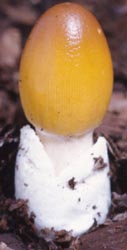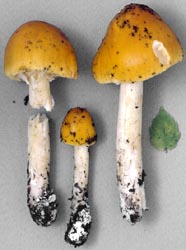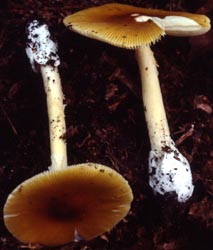[ Section Caesareae page. ]
[ Amanita Studies home. ]
[ Keys & Checklist/Picturebooks ]
[ Great Smoky Mtns. N.P. & region list ]
[ New Jersey & region list ]
[ Draft description of, & key to, sect. Caesareae ]
"Mary Banning's Slender Caesar"





Technical description (t.b.d.)
BRIEF DESCRIPTION: The cap of Amanita banningiana is 40 - 115 mm wide, orange with a rather narrow yellow margin to yellow-orange to yellow-bronze, with an umbo often becoming darker to rich yellow brown to more reddish brown with age , brown tint sometimes spreading from the umbo toward the margin while maturing, virgate, ovate to rounded conic at first, then broadly campanulate or rounded-campanulate to hemispheric to plano-convex, finally with upward flaring margin, umbonate, lubricious to tacky, dull to subshiny to shiny according to stages of drying, with a strongly striate margin (25 - 40% of the radius), nonappendiculate. The volva is absent or rarely present as a patch, white, thin, membranous, and detersile. The flesh is off-white to very pale yellow to pale yellow, sometimes paler than stem flesh, yellow to yellow orange under the cap skin, sometimes brownish under cap skin in the center, unchanging when cut or bruised, 3 - 12 mm thick above the stem, thinning evenly for one half to four-fifths to nearly all of radius, then a membrane to margin.
The gills are free to narrowly adnate, close to subcrowded to crowded, pale yellow to yellow in mass, yellowish white to light yellow in side view, sometimes somewhat deeper yellow near contact with cap flesh or near edge, unchanging when cut or bruised, 3 - 9.5 mm broad, with the broadest point two thirds of radius from the stem to the margin, sometimes forking and anastomosing, without decurrent line on top of stem or with a short line or decurrent tooth. The short gills are truncate to subtruncate to rounded truncate to subattenuate.
The stem is 80 - 223 × 6 - 15 mm, with yellow to pale yellow fibrils on cream to pale yellow ground color, paler above the ring, sometimes nearly white toward base, sometimes darkening from handling, narrowing upward or nearly cylindric, sometimes flaring at the top of the stem at maturity, at times sinuate, finely pruinose at the top, at times satiny in remainder of upper half, longitudinally striatulate in (at least) the lower quarter. The ring is placed in the upper portion of the stem, white to cream to yellow, with upper surface paler than stem surface, with underside often more deeply pigmented, membranous, skirt-like, ample, persistent, striate on upper surface, with edge sometimes thickened, sometimes with white, wispy, submembranous pieces of limbus internus appendiculate from edge. The saccate volva is rather thick (e.g., 1 - 3 mm thick at mid-height of limb), soft and cottony on exterior, white, membranous, rather tough, egg-shaped at first, becoming somewhat thimble-shaped or larger or remaining more ovoid, opening irregularly, 17 - 54 × 9 - 22 mm, often with (occasionally robust—to 2.5 mm thick) limbus internus at point of attachment of volva to stem or up to one-third of distance up the limb from that point. The flesh is paler than to concolorous with surface (often exactly as in the cap flesh), unchanging when cut or bruised, stuffed at first with creamy cottony material, then hollow with occasionally stuffed base.
The spores measure (7.5-) 8.4 - 11.9 (-15.0) × (5.2-) 5.9 - 7.8 (-9.8) µm and are ellipsoid and inamyloid.
This species is awaiting formal publication. Its range extends from Maine to Alabama and west to Wisconsin. It seems most common north of the Carolinas. It is solitary to subgregarious and is associated with oak-beech-hickory forests (Quercus spp., Fagus grandifolia, Carya spp. including C. ovata) (New Jersey); in oak-beech-Canadian hemlock (Tsuga canadensis) forests (Connecticut); in mixed forests including maple (Acer), dogwood (Cornus florida), oaks (including Q. alba), and Rhododendron (South Carolina); and in low-lying mixed forests including Sweetgum (Liquidambar styraciflua), Yellow Poplar (Liriodendron tulipifera), pines (Pinus echinata and P. taeda), oaks (Q. stellata, etc.), and Sassafras (S. albidum) (Virginia).
Amanita banningiana is assignable to Amanita stirps Hemibapha. Macroscopically, its is distinguished by a predominantly brilliant yellow cap that develops an orange-brown tint in the center which often eventually spreads nearly over the entire cap and a stem having a pale yellow ring and yellow, felted fragments of an internal limb spread over a pale yellow ground. Like many species of stirps Hemibapha, the stem is connected to the volva only at the very base. This fruiting bodies of this species are usually smaller than those of A. jacksonii Pomerleau and A. arkansana Rosen. The present species largely overlaps the northern part of the range of A. jacksonii and the more southerly range of A. arkansana. The reader may also wish to compare the present species to A. javanica< (Corner & Bas ) T. Oda, C. Tanaka & Tsuda. -- R. E. Tulloss and L. Possiel
Photos courtesy of Walter Sturgeon (top left, Ohio); R. E. Tulloss (top middle, New York; top right, Massachusetts; bottom row, New Jersey).
[ Section Caesareae page. ]
[ Amanita Studies home. ]
[ checklist/picturebooks ]
[ Great Smoky Mtns. N.P. & region list ]
[ New Jersey & region list ]
[ Draft description of, & key to, sect. Caesareae ]
Last change 27 September 2009
This page is maintained by R. E. Tulloss.
Copyright 2006, 2008, 2009 by Rodham E. Tulloss.